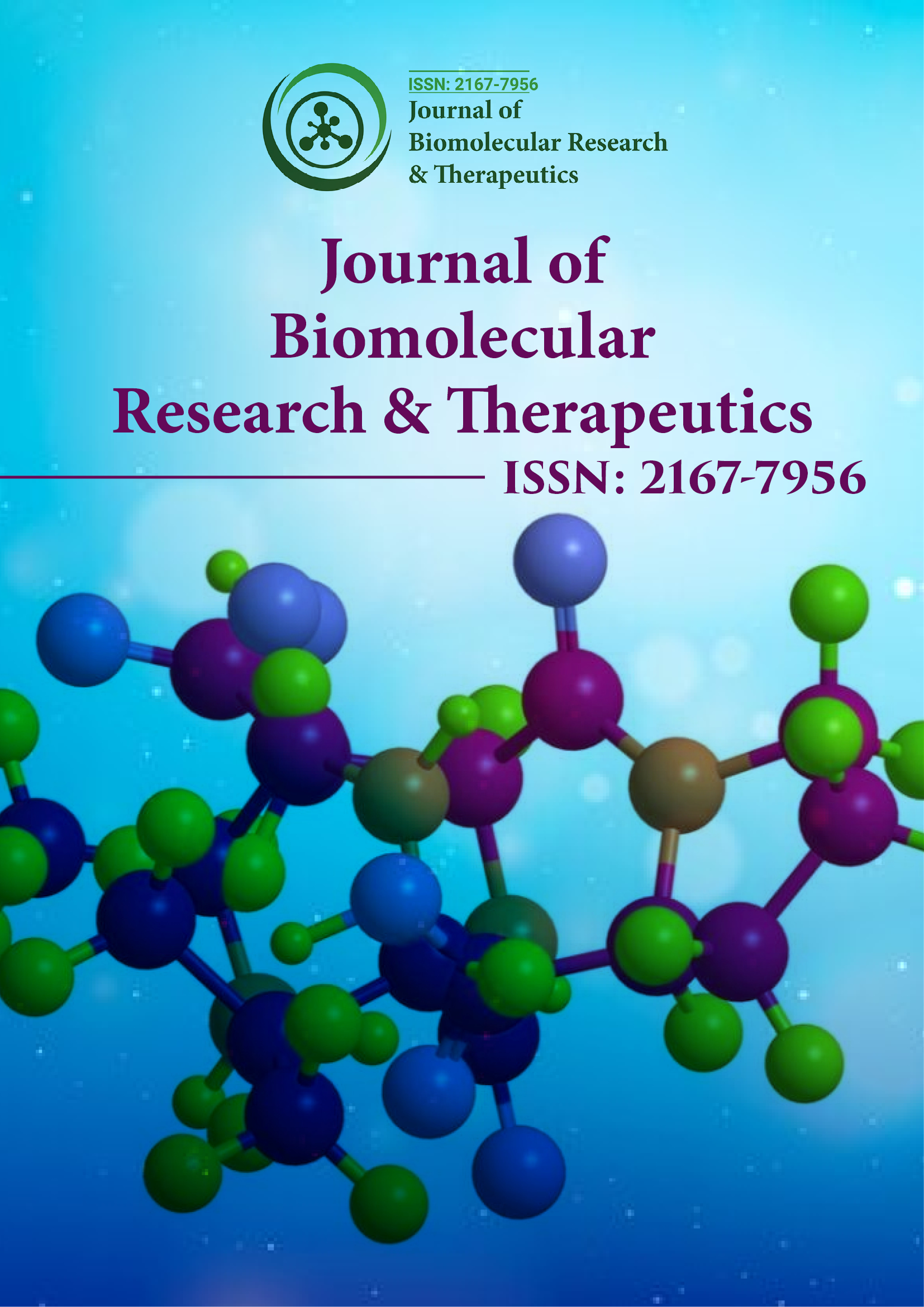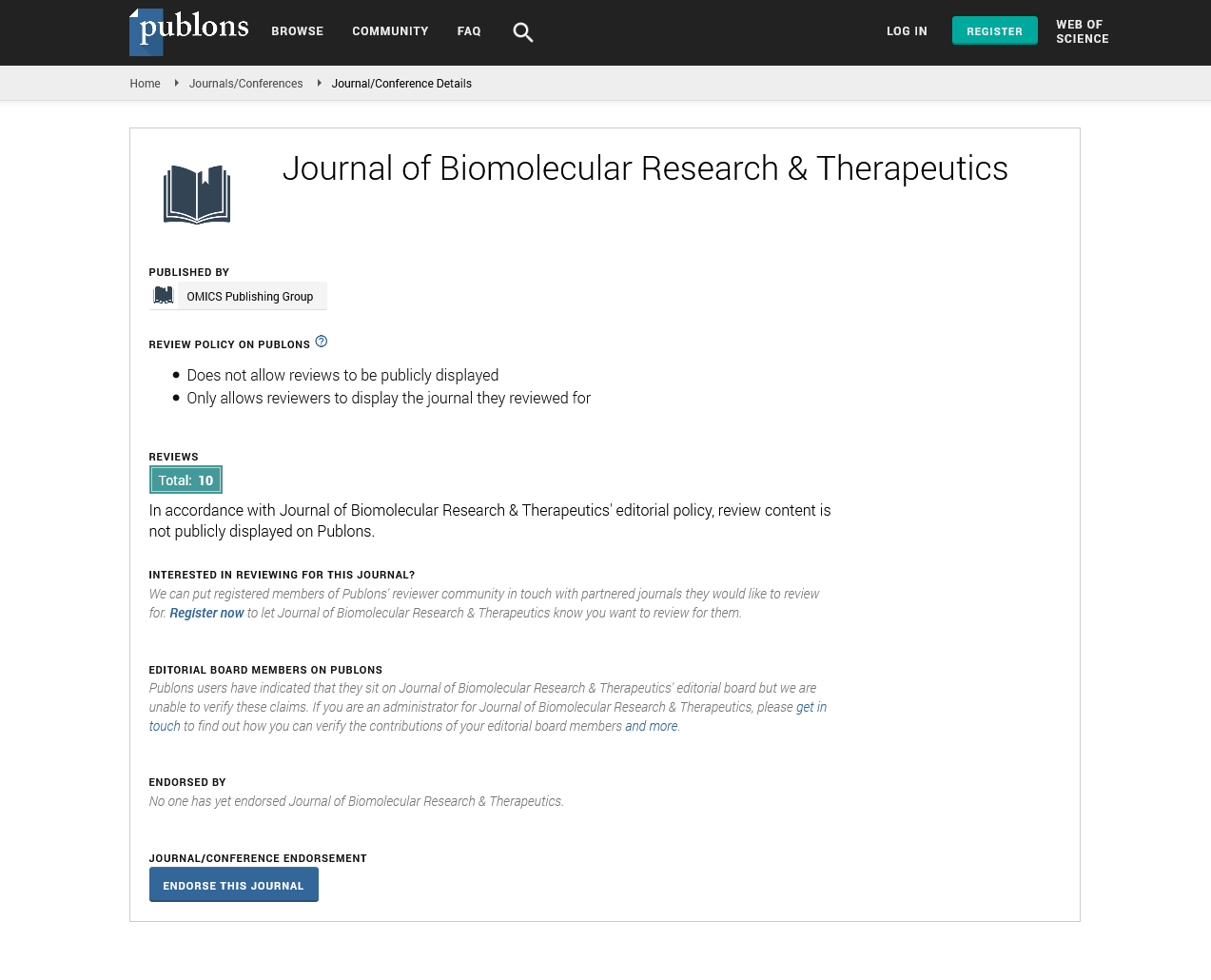Indexed In
- Open J Gate
- Genamics JournalSeek
- ResearchBible
- Electronic Journals Library
- RefSeek
- Hamdard University
- EBSCO A-Z
- OCLC- WorldCat
- SWB online catalog
- Virtual Library of Biology (vifabio)
- Publons
- Euro Pub
- Google Scholar
Useful Links
Share This Page
Journal Flyer

Open Access Journals
- Agri and Aquaculture
- Biochemistry
- Bioinformatics & Systems Biology
- Business & Management
- Chemistry
- Clinical Sciences
- Engineering
- Food & Nutrition
- General Science
- Genetics & Molecular Biology
- Immunology & Microbiology
- Medical Sciences
- Neuroscience & Psychology
- Nursing & Health Care
- Pharmaceutical Sciences
Opinion Article - (2025) Volume 14, Issue 1
StructureâFunction Analysis of a Novel Kinase Inhibitor Targeting KRAS Driven Signaling in Pancreatic Cancer
Emily Thompson*Received: 27-Jan-2025, Manuscript No. BOM-25-29320; Editor assigned: 29-Jan-2025, Pre QC No. BOM-25-29320; Reviewed: 12-Feb-2025, QC No. BOM-25-29320; Revised: 18-Feb-2025, Manuscript No. BOM-25-29320; Published: 26-Feb-2025, DOI: 10.35248/2167-7956.25.14.427
Description
Pancreatic Ductal Adenocarcinoma (PDAC) is among the most aggressive and lethal cancers, with a five-year survival rate below 10%. One of the central molecular drivers of PDAC is the KRAS oncogene, which is mutated in over 90% of cases, most commonly at codon 12 (e.g., KRASG12D, KRASG12V). These mutations result in a constitutively active KRAS protein that continuously signals through downstream effectors such as the RAF–MEK–ERK and PI3K–AKT pathways, leading to uncontrolled cell proliferation, survival and metastasis. Despite being a high-priority drug target, KRAS has historically been considered "undruggable" due to its high affinity for GTP/GDP and the lack of deep binding pockets on its surface. However, recent advances in structure-guided drug design have enabled the development of selective KRAS inhibitors, particularly for certain mutant variants. In this study, we present a structure–function analysis of a novel small-molecule inhibitor, referred to as KRSi-47, designed to selectively bind and inhibit mutant KRASG12D, which is one of the most prevalent and therapeutically challenging KRAS mutations in PDAC [1].
Using X-ray crystallography, we resolved the crystal structure of KRSi-47 bound to KRASG12D at a resolution of 1.9 Å, revealing a high-affinity interaction with the switch II pocket an allosteric site located adjacent to the nucleotide-binding domain. The binding mode involved key hydrogen bonding with Asp92 and hydrophobic interactions with residues Ile36 and Tyr96, stabilizing the KRAS protein in an inactive GDP-bound conformation. Computational docking studies and molecular dynamics simulations further confirmed the binding stability and specificity of KRSi-47 toward KRASG12D compared to wild-type KRAS. Medicinal chemistry optimization of the core scaffold of KRSi-47 improved its binding affinity (KD ~ 20 nM) while maintaining excellent selectivity over other small GTPases and off-target kinases [2].
Biochemical assays using recombinant KRASG12D protein showed that KRSi-47 effectively inhibits the GDP–GTP exchange catalyzed by the SOS1 guanine nucleotide exchange factor, thereby preventing KRAS activation. In cell-based studies, KRSi-47 exhibited potent growth-inhibitory effects in PDAC cell lines harboring KRASG12D mutations (e.g., MIA PaCa-2, Panc-1), with ICâ??â?? values in the low nanomolar range. In contrast, KRAS wild-type or KRASG13D-expressing lines showed minimal sensitivity, underscoring the mutation-specific activity of KRSi-47. Western blot analysis demonstrated significant suppression of phospho-ERK and phospho-AKT levels, indicative of downstream pathway inhibition. Apoptosis assays revealed an increase in caspase-3/7 activation and PARP cleavage upon treatment, confirming that KRSi-47 induces apoptotic cell death in KRAS-mutant PDAC cells [3].
In vivo efficacy was evaluated in a subcutaneous xenograft model using immunocompromised mice implanted with MIA PaCa-2 tumors. Mice treated with KRSi-47 (30 mg/kg orally, once daily) exhibited significant tumor growth inhibition compared to the vehicle control group, with a reduction in tumor volume of over 65% after 21 days of treatment. Pharmacokinetic profiling demonstrated good oral bioavailability (approximately 48%), a favorable half-life (~6.2 hours) and no evidence of major organ toxicity. Hematological and biochemical parameters remained within normal ranges and histological analysis of major organs showed no signs of inflammation or necrosis. Notably, combining KRSi-47 with gemcitabine a standard chemotherapeutic agent for PDAC produced a synergistic antitumor effect, further reducing tumor size and enhancing apoptosis, without increasing systemic toxicity [4].
To explore resistance mechanisms, long-term exposure studies were performed. While some PDAC cells developed partial resistance to KRSi-47 over several months, this was associated with upregulation of alternate survival pathways, particularly increased expression of YAP1 and mTOR signaling components. This suggests that rational combination therapies may be required to prevent or overcome acquired resistance. Future directions may include combining KRSi-47 with inhibitors targeting parallel pathways or with immune checkpoint blockade in immunocompetent models [5].
The implications of this study are significant for targeted therapy in pancreatic cancer, a field where therapeutic advances have been slow despite considerable research. By focusing on the structural and functional characterization of KRSi-47, we demonstrate a promising avenue for selectively targeting KRASG12D in pancreatic cancer using small molecules. These findings not only contribute to the ongoing efforts to "drug" KRAS mutants but also provide a blueprint for the rational design of mutant-selective inhibitors using structure-based approaches. As this compound progresses toward further preclinical and potential clinical development, it holds promise for improving the prognosis of patients with KRAS-driven pancreatic cancer, a group that has historically had few effective treatment options [6-10].
References
- Nudler E. RNA polymerase active center: The molecular engine of transcription. Annu Rev Biochem. 2009;78:335-361.
[Crossref] [Google Scholar] [PubMed]
- Clarke J, Wilhelm FK. Superconducting quantum bits. Nature. 2008;453:1031-1042.
[Crossref] [Google Scholar] [PubMed]
- Bennett R, Barlow TM, Beige A. A physically motivated quantization of the electromagnetic field. Eur J Phys. 2016;37:014001.
- Kohestani H, Wereszczynski J. The effects of RNA.DNA-DNA triple helices on nucleosome structures and dynamics. Biophys J. 2023;122:1229-1239.
[Crossref] [Google Scholar] [PubMed]
- Du X, Qin W, Yang C, Dai L, San M, Xia Y, et al. RBM22 regulates RNA polymerase II 5′ pausing, elongation rate and termination by coordinating 7SK-P-TEFb complex and SPT5. Genome Biol. 2024;25:102.
[Crossref] [Google Scholar] [PubMed]
- Klein CA, Teufel M, Weile CJ, Sobetzko P. The bacterial promoter spacer modulates promoter strength and timing by length, TG-motifs and DNA supercoiling sensitivity. Sci Rep. 2021;11:24399.
[Crossref] [Google Scholar] [PubMed]
- Xu J, Chong J, Wang D. Opposite roles of transcription elongation factors Spt4/5 and Elf1 in RNA polymerase II transcription through B-form versus non-B DNA structures. Nucleic Acids Res. 2021;49:4944-4953.
[Crossref] [Google Scholar] [PubMed]
- Korzheva N, Mustaev A, Kozlov M, Malhotra A, Nikiforov V, Goldfarb A, et al. A structural model of transcription elongation. Science. 2000;289:619-625.
[Crossref] [Google Scholar] [PubMed]
- Yun K. Two types of electric field enhancements by infinitely many circular conductors arranged closely in two parallel lines. Q Appl Math. 2017;75:649-676.
- Sabari BR, Dall’Agnese A, Young RA. Biomolecular condensates in the nucleus. Trends Biochem Sci. 2020;45:961-977.
[Crossref] [Google Scholar] [PubMed]
Citation: Thompson E (2025) Structure Function Analysis of a Novel Kinase Inhibitor Targeting KRAS Driven Signaling in Pancreatic Cancer. J Biol Res Ther. 14:427.
Copyright: © 2025 Thompson E. This is an open access article distributed under the terms of the Creative Commons Attribution License, which permits unrestricted use, distribution AND reproduction in any medium, provided the original author and source are credited.

